On Outside Online, Monday, July 2, 2012, Stephanie Pearson nominated “The Best Whitewater Rafting: 1. Franklin River, Tasmania, Float in Eco-friendly style”
In October 2013 she paddled the Franklin on our 7-Day Full River Trip . This is her story…
Surviving Tasmania
A fascination with a cartoon animal and a Class V river lured her to the empty wilderness of Tasmania. Turns out the raw side of Down Under offers an amazing number of pristine places to camp, surf, hike, mountain bike, and kayak. Stephanie Pearson goes all in.
The cave is like a womb. Cocooned in my sleeping bag, I stare a foot above me at whorls of coral and register that I’m lying under thousands of tons of overhanging rock. We’re camping alongside the Franklin River at the Newlands Cascades rapids, in the shallow caves that form the base of a limestone wall 100 feet high. I can make out a delicate web on the ceiling, likely the work of a Tasmanian cave spider, and wonder if a tiger snake, the world’s fourth-deadliest serpent, will slither past. But that’s not my most pressing concern.
The rain has been pouring down in sheets for the past 12 hours, and the thundering rush of the swiftly rising Franklin is just 30 feet below. The 78-mile-long, pool-drop river boils with technical Class III–VI rapids crashing through the nearly impenetrable Franklin-Gordon Wild Rivers National Park, in the heart of the 3.5-million-acre Tasmanian Wilderness World Heritage Area. Its tannin-stained water is as dark as Guinness beer but so clean we drink it straight, with no filtration. The Franklin flows through a deep ravine (1,300 feet at its deepest) and is so wet (100 inches of precipitation per year fall in some places) that just two inches of rain can cause it to rise ten feet in two hours. Which is what I fear is happening now.
The river has risen 13 feet since our seven-person group—four Australians, one South African, one Austrian, and me—arrived at the campsite two days ago with dramatic flourish. Right before eddying out, Ron Wiffen, a 63-year-old plumber from Queensland, and Graham Freeman, a 25-year-old from Johannesburg, who were powering the front of our 15-foot rubber raft, were deep-sixed headfirst into the 50-degree water after we banged into a boulder.
The next day, which we spent exploring, went smoothly. We swung like monkeys on branches, bushwhacking through the temperate rainforest, a primeval garden of giant man ferns, sassafras, pandani, and rare, slow-growing, 130-foot Huon pines that were here before Christ, in wilderness so empty that we’ve seen zero people in six days. But the rain started late that night and has remained steady, stranding us for the foreseeable future. Brett Fernon, our 53-year-old Aussie guide and the owner of outfitter Water by Nature Tasmania, tells me that this is the highest level he’s ever seen. “Bloody hell! I don’t think it’s peaked yet,” he says, scanning the narrow sliver of sky. “It’s a bit tricky trying to get out of here at the moment.”
We’re not the first party to be buggered by the Franklin. Fewer than 500 people per year attempt it, and some don’t come out the other end. In 1822, eight convicts fled into the Franklin watershed to escape Sarah Island prison, the British Empire’s version of the Gulag Archipelago, on Tasmania’s west coast. Only one man, Alexander Pearce, walked out alive—after killing and eating five of his fellow escapees. The river’s namesake, colonial governor and Arctic explorer Sir John Franklin, crossed the waterway but never paddled its length. (He died of starvation in 1847 while searching for the Northwest Passage.) And in 1994, author Richard Flanagan wrote Death of a River Guide, a grim read based on his own near drowning on the Franklin. The book is sitting next to my sleeping bag.
Fernon’s oft repeated mantra echoes through my brain: “You can never be too paranoid down here.” He would know. The so-called Godfather of the Franklin has paddled the river more than 200 times in the past 26 years. A lanky six foot one, he’s a registered nurse and Sydney native, and he resembles a bird of prey, with winged graying hair, a beaked nose, and fierce intensity when he’s on the water. When he’s relaxed, he unleashes a goofy, talkative side while whipping up dinner. Fernon’s seen it all down here, including runaway rafts, snake-infested campgrounds, bones and boats cracked in half, and helicopter evacs. But he feels at home on the Franklin, even as it’s threatening us. “We’ve been trapped by Mother Nature,” he says. He sounds exhilarated.
The Franklin River is a fitting metaphor for Tasmania: beautiful, terrible, sublime, bizarre, and very, very remote. This West Virginia–size island invented the bushranger (the Oz version of an outlaw hero), gave Hollywood Errol Flynn (who was born in Tasmania’s capital, Hobart), and established the world’s first green party in 1972.
I’ve been obsessed with the island’s extremes for years. I was raised on Looney Tunes, and my interest was aroused by the Tasmanian Devil, a.k.a. Taz, a whirling dervish that zoomed around like a tornado, slicing through boulders and trees. In 2000, I cycled and road-tripped for six weeks through mainland Australia while reading Robert Hughes’s The Fatal Shore, a history of Oz’s settling, in which Tasmania played a critical and dark role. In 1803, the British capitalized on the island’s isolation, colonizing it as Van Diemen’s Land, the dumping ground for repugnant criminals, harmless urchins, and homeless women. It took the penal colony just 73 years to wipe out the estimated 4,000 pure-blood Aboriginal people, whose lineage here dates back 40,000 years. It took only 60 more for the motley crew, along with the few free settlers who chose to live among them, to hunt the thylacine, or Tasmanian tiger, to apparent extinction. But the convicts who managed to stay out of trouble served their seven years of hard labor and took advantage of the freedom in Tasmania. Even today, the state’s license plate reads Explore the Possibilities.
Because their ancestors forged civilization out of ferocious wilds, many Tasmanians have a deep love and respect for untouched territory. More than 40 percent of Tasmania’s landmass is protected in reserves, World Heritage Areas, and 19 national parks. “In a world where wilderness is perhaps the fastest-disappearing natural resource and the pristine values of nature are being destroyed at a great rate, Tasmania is like a Noah’s Ark,” says Bob Brown, a medical doctor and the state’s most iconic environmentalist; he was the head of the Wilderness Society, then went on to spend 16 years as a Green Party senator in the federal government. “Our glory days are ahead of us, but not without eternal vigilance.”
There’s a lot worth protecting. Of Tasmania’s 500,000 residents, 212,000 live in Hobart, a funky waterfront city on the slopes of 4,166-foot Mount Wellington, with paved and off-road hiking and mountain-biking trails in every direction. The city sits on the mouth of the Derwent River, which flows into the Tasman Sea, and its convict-built, waterfront sandstone facades have been renovated into hipster hotels, restaurants, and bars—at least five floating shacks sell fish-and-chips in the harbor. They’re all packed with locals, climate scientists on break from Antarctica, or Asian tourists dining on the day’s oyster and seafood catch, accompanied by pinot noirs produced just down the road. One reason the state is getting an infusion of international travelers is MONA, the Museum of Old and New Art, a $200 million steel bunker dreamed up by local gambling tycoon David Walsh that is full of provocative works—like a defecating machine that unleashes “feces” at 2 p.m. every day.
Beyond Hobart, there are countless treks, including seven Great Walks, and 3,355 miles of coastline. The annual Sydney-to-Hobart yacht race, a 628-mile sufferfest, is one of the most coveted cups in sailing, and surfers flock to the consistent breaks near the east-coast town of Bicheno or to the more extreme swell at Shipstern Bluff off the Tasman Peninsula, renowned for 40-foot waves, great white sharks, and the possibility of crashing into a 200-foot-high cliff.
And Tasmania contains a number of animal species that live nowhere else, including marsupials like the Tasmanian bettong, eastern quoll, Tasmanian pademelon, and, some scientists believe after alleged recent sightings, the Tasmanian tiger. There’s also the notorious Tasmanian devil, a skunk-size, carnivorous marsupial, which is sadly being driven to extinction by devil facial tumor disease, a cancer that has likely killed 80 percent of the species.
But there’s a flipside to all this wonder. Tasmania is the poorest state in Australia, and it has a fierce loyalty to forestry, mining, and hydropower. The state’s resource battles are reminiscent of environmental fights around the globe, except here they’re on a finite stage, which makes the island a sort of petri dish for the rest of us. Last summer, Tasmania’s Parliament passed the historic Tasmanian Forest Agreement, which will add 420,000 acres to the existing Tasmanian Wilderness World Heritage Area and transfer a total of 1.2 million acres of vulnerable native forests from Forestry Tasmania to the Parks and Wildlife Service. If the right-wing Liberal Party comes to power this spring, however, its leadership has vowed to reverse the agreement and log in the World Heritage Area. Meanwhile, many of the remaining disease-free Tasmanian devils live in the Tarkine, a 1.2-million-acre unprotected wilderness also in a conservation battle. Environmentalists are lobbying for national park and World Heritage status, but competing for space are timber leases and proposals for ten new tin and iron-ore mines, slated to roll into operation over the next five years.
It seemed like a good time to explore the state’s rawness and dichotomies, in the fickle height of spring, when the lilacs bloom, horizontal snow falls, and the sun beats down, all within a few hours. And there’s no better place to start than the Franklin, a flash point in Tasmania’s conservation history, too: led by Bob Brown, 2,500 protestors formed a human blockade in 1982 to stop a hydroelectric dam. (Their efforts were rewarded.) I’d heard about the river a couple of years ago from Peter Grubb, the founder of Idaho-based Row Adventures, who described an almost mythic Tasmanian wilderness, known among guides as having one of the most technical whitewater runs in the world. I knew I had to see it for myself.
It’s 2:22 a.m., and the river is still rising. Fernon and his co-guide, a 38-year-old transplanted Austrian named Klaudia Marte, shine like apparitions in the glow of their headlamps as they drag the rafts 15 feet farther up the limestone shelf and place them on our stone dining room table. I can’t move any higher, so I cover my head with my sleeping bag and wait until whichever comes first: dawn or drowning.
At 6:55 a.m., it’s still raining, and the water level is now two feet higher than Fernon has ever seen it, but it miraculously retreats enough for us to consider launching into a sketchy Class IV wave train. At 10 a.m., the rain stops. We load, launch, and paddle, whooping like rodeo cowboys. Beyond the first hurdle, the river is so swollen that the rapids have disappeared, replaced by swirling boils. We book it 26 miles downriver to the confluence of the Gordon, which was dammed in 1972, in record-setting time. An hour before we reach the shelter of a hydro-workers’ hut, the pelting rain resumes. “This is the moment I question my sanity,” says Ron Wiffen, who was ejected out of the raft a few days ago.
Possibly hypothermic, or maybe just euphoric to have safely shepherded everyone off the Franklin, Fernon stands up in the raft, shakes his fist at the sky, and yells at the top of his voice in mock-apostle style: “Is this all you’ve got?! C’mon! Bring it!”
Our floatplane is grounded in Hobart, so the next day at dawn we catch a ride with a yacht that motors us six hours across Macquarie Harbor to Strahan, where a van drives us six hours back to Hobart. But first we raise our plastic glasses of Shiraz in a toast to a perfect trip.”Who wants a life that goes according to plan?” says Dave James, a 38-year-old consultant and outdoor-education guide in Hobart and the only native Tasmanian in our group. “There’s no fun in that.”
That’s part of the charm of Tasmania—the weather can derail even the best-laid plans. A day after I’m off the river, I meet up in Hobart with a rugged, 28-year-old, fifth-generation Tasmanian named Rob Knight, my guide for the next eight days. Knight, who lives with his fiancée on a 32-foot sailboat south of the city, has mapped out a 1,000-mile drive with stop-offs to explore the east coast’s vacant beaches and the state’s famous treks. “I like to come home bleeding and covered in mud,” says Knight. “It’s a bit masochistic, isn’t it?”
We make a quick first stop at Freycinet Peninsula, 121 miles from Hobart, and walk to the overlook of Wineglass Bay, a famous stretch of sand that’s like the Playboy centerfold of beaches, with perfect, bodacious curves. Our objective the next day is to hike a truncated version of the 40-mile-long Overland Track, which starts at Cradle Mountain–Lake St. Clair National Park and traverses a World Heritage Area that includes Tasmania’s highest peak, 5,305-foot Mount Ossa; its deepest lake, St. Clair; and miles and miles of wide-open views to the Pelion Range. Trekkers who do the six-day through-hike have three options: camp, stay in basic government huts with bunks, or book a trip through an independent operator and end the day in a private hut with a hot shower, a few glasses of Tasmanian wine, fresh bread, and a fluffy bed. Instead of a through-hike, we’ll veer off-track and climb 5,069-foot Cradle Mountain, the most photographed feature in Tasmania, which looks like it has a handsaw blade for a summit, and be back at Cradle Mountain Lodge in time for dinner.
As the trail winds upward, I learn just how masochistic Knight is. In less than three decades, he has crossed the Southern Ocean 66 times as an Antarctic guide, run an off-the-couch Antarctic half-marathon fueled by Red Bull, and become the youngest Australian to ski to the North Pole, which he did with a broken wrist. He has also kayaked the Franklin, a rite of passage for every budding Tasmanian badass. In addition to guiding, Knight just launched a new company, the Bruny Island Long Weekend. It’s a three-day, yacht-in, fly-out luxury escape on Bruny, a mountainous 62-mile-long stretch of land just down the D’Entrecasteaux Channel from Hobart, with world-famous oysters (which, I’m able to confirm when I visit a few days later, deserve their reputation) and an obscenely perfect seven-mile beach.
Given Tasmania’s notoriously fickle weather, our hike quickly turns feisty. We’re at 5,000 feet, but it may as well be 17,500. Near the summit—which requires postholing through snow, followed by a slippery scramble over sandpapery dolerite boulders—the winds amp up to 50 miles per hour. We slip and slide to a hut at the base of Cradle Mountain to warm up with a cup of tea before hightailing it five miles back to the trailhead.
By the time we reach the Tasman Peninsula two days later, the sun is blazing. Just 90 minutes southeast of Hobart, the peninsula is home to Capes Hauy, Pillar, and Raoul, which rise hundreds of feet above the Tasman Sea and will be connected by the 40-mile Three Capes Track starting in the fall of 2015. We hike Hauy, then visit the gut-wrenching World Heritage prison site of Port Arthur. It looks like a Scottish castle grounds, with imposing sandstone facades surrounded by lush lawns and rosebushes. But it’s the home of many past horrors, including the Separate Prison, a chamber of solitary confinement in which convicts weren’t allowed to speak and were forced to wear masks. The goal was to break down the mind as well as the body, perhaps one of the reasons the freed prisoners would later fare so well in the wilderness.
Offshore, though, things get more fun. Knight sends me off on Rob Pennicott’s 46-mile boat tour along the Tasman Peninsula. Fifteen years ago, the 48-year-old entrepreneur founded Pennicott Wilderness Journeys, a tour company that offers thrill rides in 43-seat rigid inflatables that can bash through the Tasman Sea to reach otherwise unreachable stretches of the coastline. Between the 1,000-foot stands of dolerite and the 20-foot ocean swells, the coastline looks like an impenetrable prison fortress. But it’s impossible not to laugh out loud as the boat gyrates among dolphins, white-bellied sea eagles, albatross, a colony of seals, and a breaching humpback whale.
Almost everyone I meet in Tasmania has conservation on his mind. “My dad worked for hydro, which dammed a lot of Tasmania, but I believe we have to have balance,” Pennicott, who donates 25 percent of his company’s profits to local environmental causes each year, told me when I met him in Hobart before the boat ride. “Economic development is important, but sustainability is everything.”
The fact that I didn’t contract giardia by drinking from the Franklin River sends shivers of hope for Tasmania down my spine. Before my odyssey with Knight ends, he shows me the eastern edge of the Tasmanian Wilderness World Heritage Area, the opposite side to where the Franklin flows. We drive 90 minutes southwest of Hobart, past the logging town of Geeveston, to the trailhead of Hartz Peak. In a few hours, we’re at the 4,117-foot summit, a conical pile of dolerite. Despite the proximity to Hobart and it being a Sunday afternoon, we’ve seen only three other hikers. Directly east is civilization: a clear-cut forest and the pastoral orchards and vineyards of the Huon Valley. To the west, clouds roll in from the ocean like waves. There’s snow on the ridges of the Western Arthurs, a line of jagged peaks that disappear in the fog. Somewhere out there, miles and miles beyond the mountains, is the free-flowing Franklin.
“There’s no way into this wilderness except your feet,” says Knight. “It’s hard to believe there’s not a Tasmanian tiger in there somewhere.”
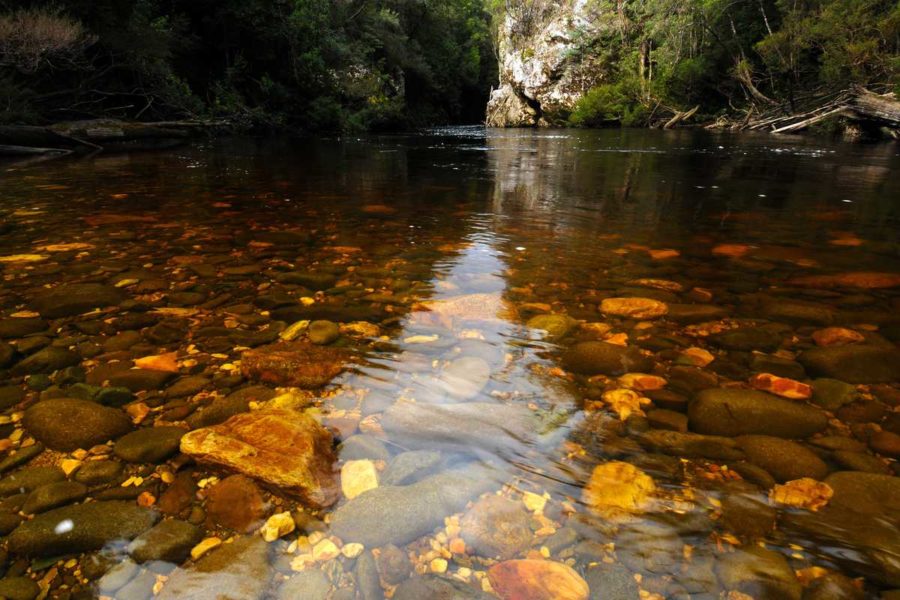
Tannins in the water 
The Irenabyss 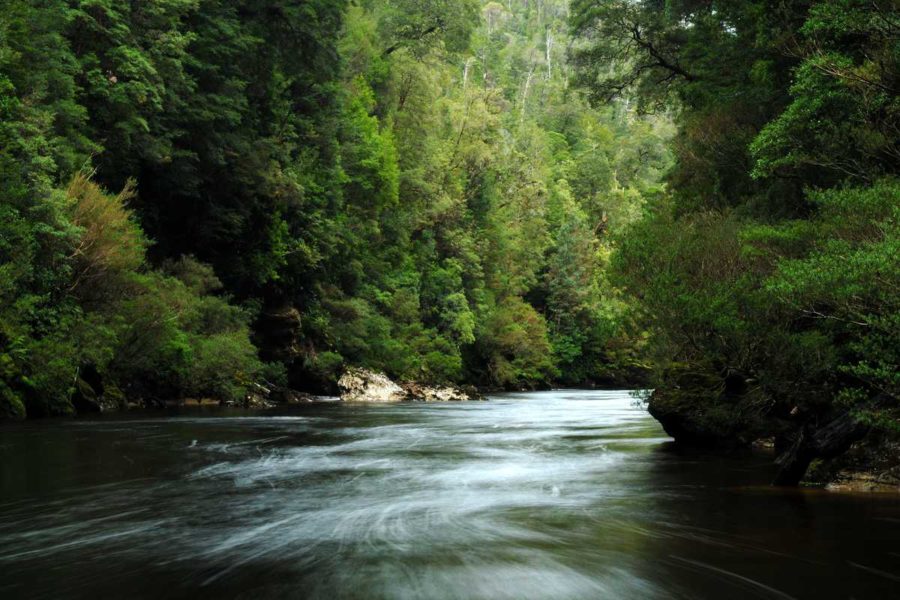
Along the Middle Franklin 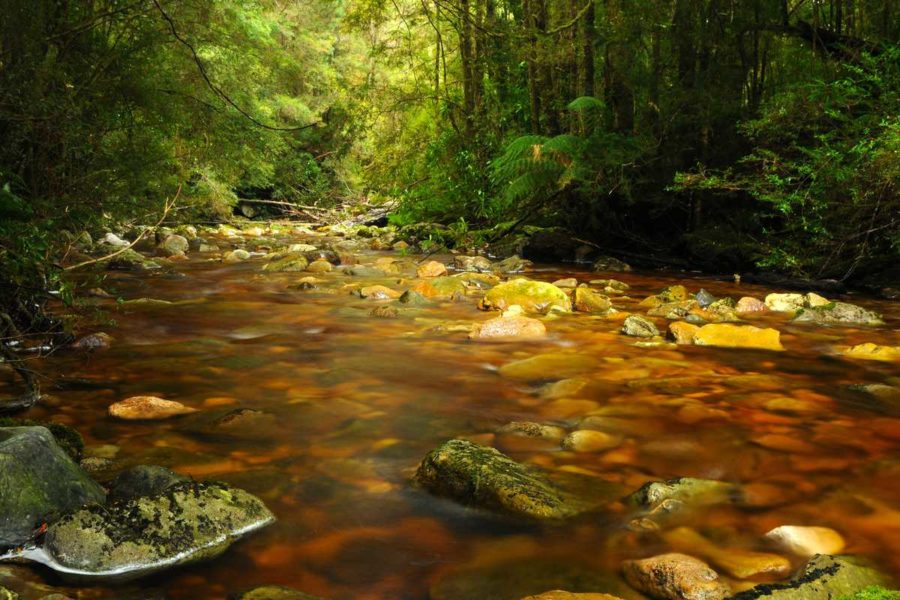
Interlude Creek 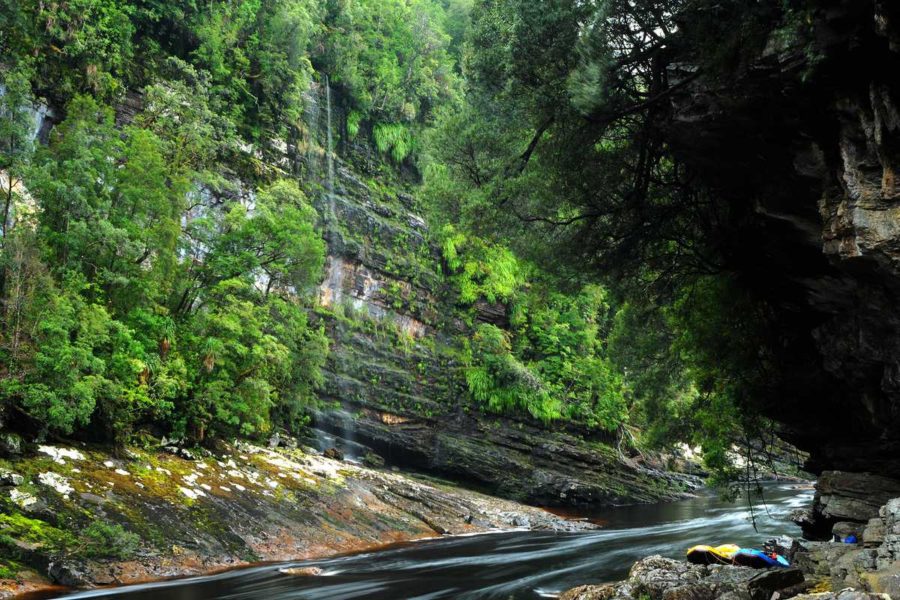
Shower Cliff waterfall 
Brett and crew running the corkscrew rapid. 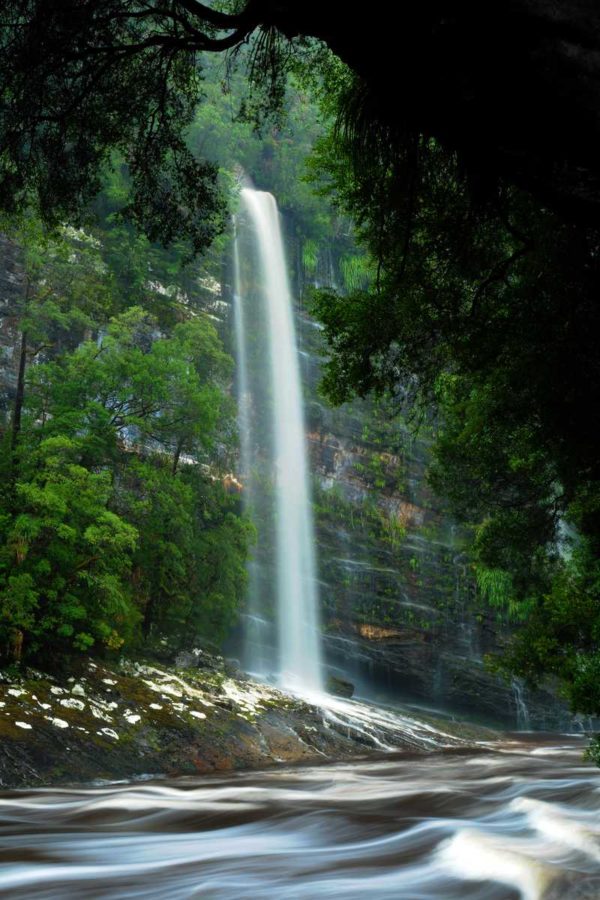
Shower Cliff waterfall 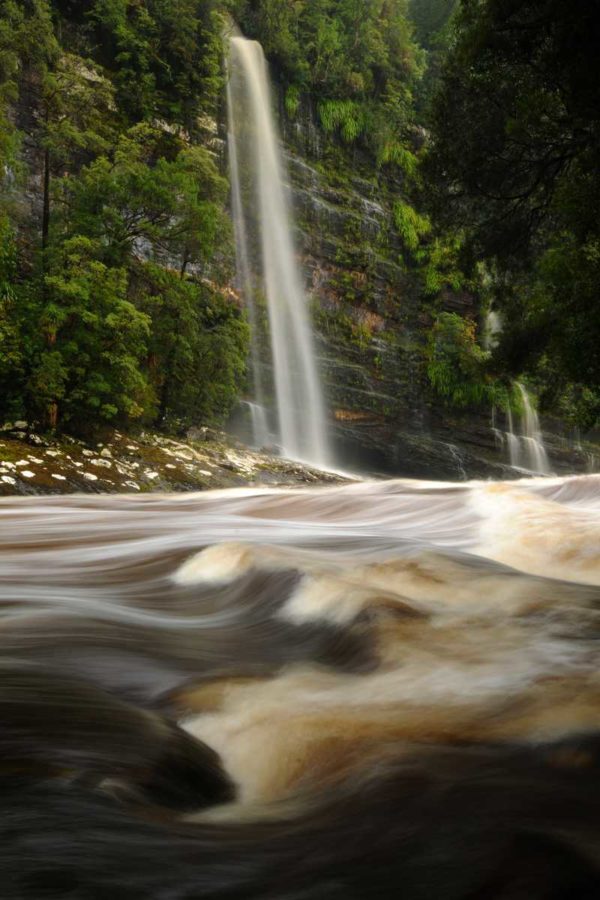
Shower Cliff waterfall

